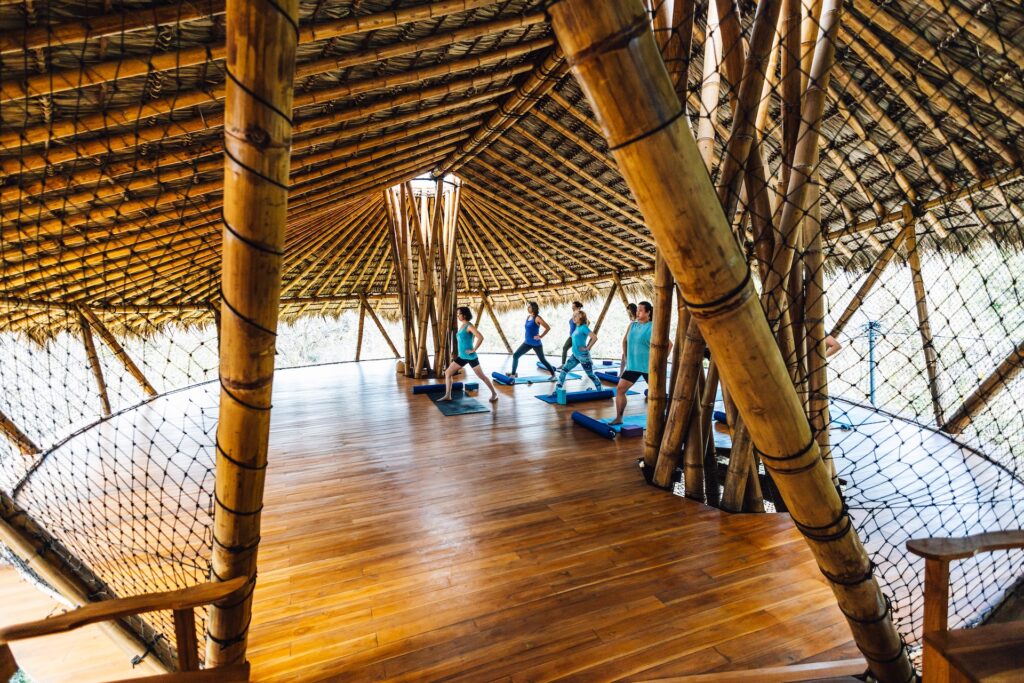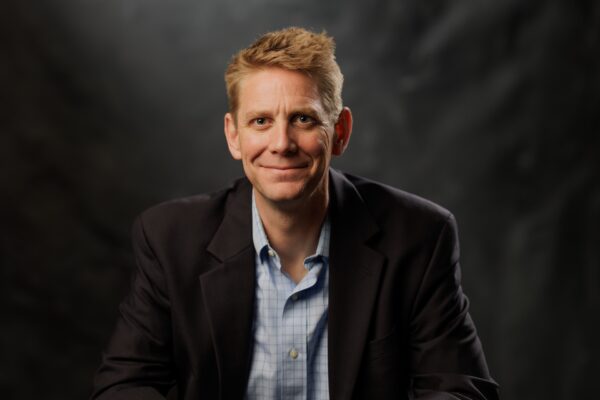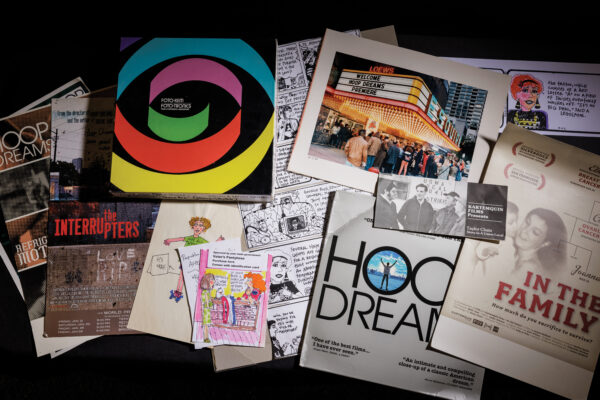Near a remote beach on the coastline of Nicaragua, about 12 kilometers from the border of Costa Rica, Edya Kalev, AB ’92, guides a group of women as they each apply gentle, purposeful pressure to their hands, feet and spine.
The retreat participants breathe deeply, letting out the occasional relaxed sigh as they release tension using specialized balls and rollers that Kalev brought from her studio in New York.
A master instructor of the MELT Method, a self-administered massage technique used for pain relief, Kalev has led such exercises for decades. But her experience this past February at Evolutions Trainings in Nicaragua stands out — both because of the idyllic setting and because of some serendipitous WashU connections.
The retreat was held in a soaring, one-of-a-kind bamboo structure where monkeys freely climbed on netted walls. Above the large oval platform where classes took place, light poured in from openings atop two distinctive bamboo columns.
“It feels like you’re part of the environment, not separate from it,” Kalev says. “You really feel like you can breathe there and that you’re not boxed in.”
That sensation, Kalev soon learned, was by design.

“I love to hear that that feeling was elicited, because our intent is to create healthier spaces,” says Wyly Brown, assistant professor at the Sam Fox School of Design & Visual Arts. Brown created the platform in 2023 with design partner Michelle Fleming, founder of Orthopedic Yoga Therapy and the owner of Evolution Trainings retreat center.
Brown and Fleming have together studied bamboo construction techniques around the world, including in Bali, Costa Rica and the U.S. With the retreat space in Nicaragua, they worked in partnership with local craftspeople to experiment with sustainable, healthy building techniques.
“The way I do a lot of my practice is what’s called ‘research through design,’” Brown explains. “I design real structures and test some aspect. It’s research that becomes a viable structure instead of being thrown away.”
Brown’s students have gotten involved, both abroad and in St. Louis–based projects, leading to yet another unexpected WashU connection in Nicaragua. During the February retreat, Kalev met Orion Strayer, AB ’24, who as a WashU undergraduate had been one of Brown’s research assistants. Strayer had journeyed to Evolutions Trainings to work for six weeks as a bamboo design intern.
“I’m grateful to Wyly Brown for the opportunities he has given me over the years,” Strayer says. “Not just because he is an incredible designer and mentor, but because of the irrepressible enthusiasm he brings to every endeavor. You have to be there to see how the construction team lights up whenever he walks onsite.”
“It was such a beautiful intersection of interests that seemed to have WashU at its center,” Kalev says. “It seemed like fate.”
“It was such a beautiful intersection of interests that seemed to have WashU at its center. It seemed like fate.”
Edya Kalev, AB ’92
The location also proved an ideal environment for practicing the MELT Method. Kalev discovered the gentle, restorative technique when, during her first class more than 20 years ago, she finally felt pain-free after dealing for months with a debilitating hamstring injury. Already a yoga instructor by training, she redirected her focus to MELT.
“It’s portable and easy to do,” Kalev says. “It feels great. I have students that tell me they feel better now than they did 10 years ago, even 20 years ago, because they’re able to do a little bit of MELT and include it in their daily routine.”
When teaching, Kalev often finds herself recalling her undergraduate studies in art history. She spends much of her time visualizing specific motions or parts of the body and then verbalizing that visualization, she says. Observing and analyzing artwork proved an effective, if unexpected, training ground for her career.
MELT techniques also pair well with Fleming’s work in Orthopedic Yoga Therapy. Fleming invited Kalev to help lead the retreat; the two first met many years earlier, when Fleming taught Kalev’s first yoga class. These days, both of their chosen specialty areas focus on connections between the body’s fascial tissues and nervous system, as well as the concept of being grounded. The friends plan to pair up for another women’s retreat as well as a Fascia Camp in February 2026.
“When I teach, I’m constantly asking people to feel grounded and to feel supported,” Fleming says. “I feel like we need that so much in our lives. The building here gives us amazing opportunities to play with looking at architecture externally so we can find the correct alignment of our own internal architecture.”
While making plans for another structure in Nicaragua, Brown emphasizes the universal value of beautiful, sustainably built architecture. He believes that building projects in the U.S. can and should use healthy materials like bamboo, as well as better connect to their natural surroundings. A new venture, the Regenerative Architecture Collective, will focus in education and experimentation, integrating Indigenous building knowledge with digital tools and state-of-the-art construction techniques.

“Post-COVID in the U.S., we spend 90% of our life indoors,” Brown says, “and a lot of the materials we build out of are very toxic for us.
“Our intent is to create healthier spaces. Health is about individual care, the care between yourself and your community, and your care and connection with the landscape and with the planet. And that’s not something that just happens in the tropics. It’s something we could do here.”
Brown is the co-founder of a private architecture firm, Leupold Brown Goldbach Architekten, focused on sustainable building practices. His portfolio ranges from museums and stadiums to multi-family housing units. After joining the WashU faculty, his research led him to a deep appreciation of bamboo as a building material.
“You kind of go down the rabbit hole,” Brown says “You realize how amazing this material is — how quickly it grows, how strong it is, how easy it is to harvest, and all these other collateral benefits such as producing oxygen and sequestering carbon. So I continued to investigate, and it has become the central body of my research at WashU.”
It’s a passion he’s passed on to his students, including Strayer. During his February internship in Nicaragua, he designed architectural additions like furniture and terraces. He also learned about the power of partnership when practicing sustainable design.
“Our intent is to create healthier spaces. … And that’s not something that just happens in the tropics. It’s something we could do here.”
Wyly Brown
“One of my most rewarding responsibilities was working with the construction team — literally working alongside them with a saw, explaining drawings or figuring out material costs,” Strayer says. “I learned that everyone’s input is crucial to success: from the owner, to the architect, to the carpenters, to the pool cleaner who is actually a genius and ends up being central to every project (shout out to Juan Lopez). If anything will stick with me forever from this experience, it is them.”
Brown and Fleming’s partnership extends beyond their shared design practice — the two will be wed on the bamboo platform in Nicaragua this November. Perhaps among those in attendance, even more WashU connections will be made.
“Our experience really shows the broad reach of a WashU education,” Kalev says about the chance connections at the February retreat. “You can get all these people coming from all these backgrounds, and somehow they come together in this unique fashion where we can build upon each other’s strengths.”
Brown nods in agreement. “You might be in your own field at a very high level, and then you meet somebody and find out they went here or taught here or have some other relationship with the university,” he says. “Everywhere you’re drifting in a state of excellence, you find somebody from WashU.”



